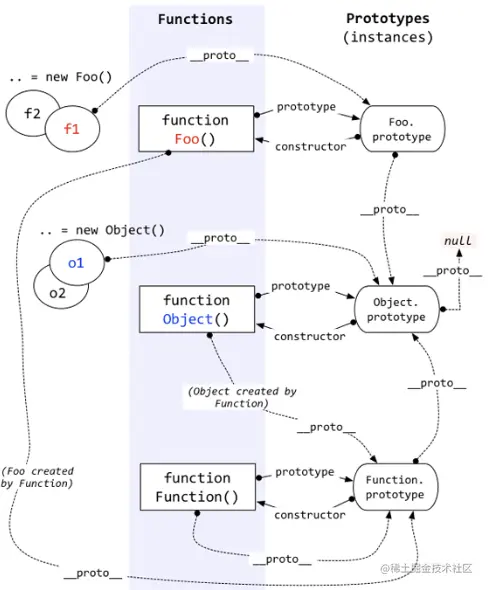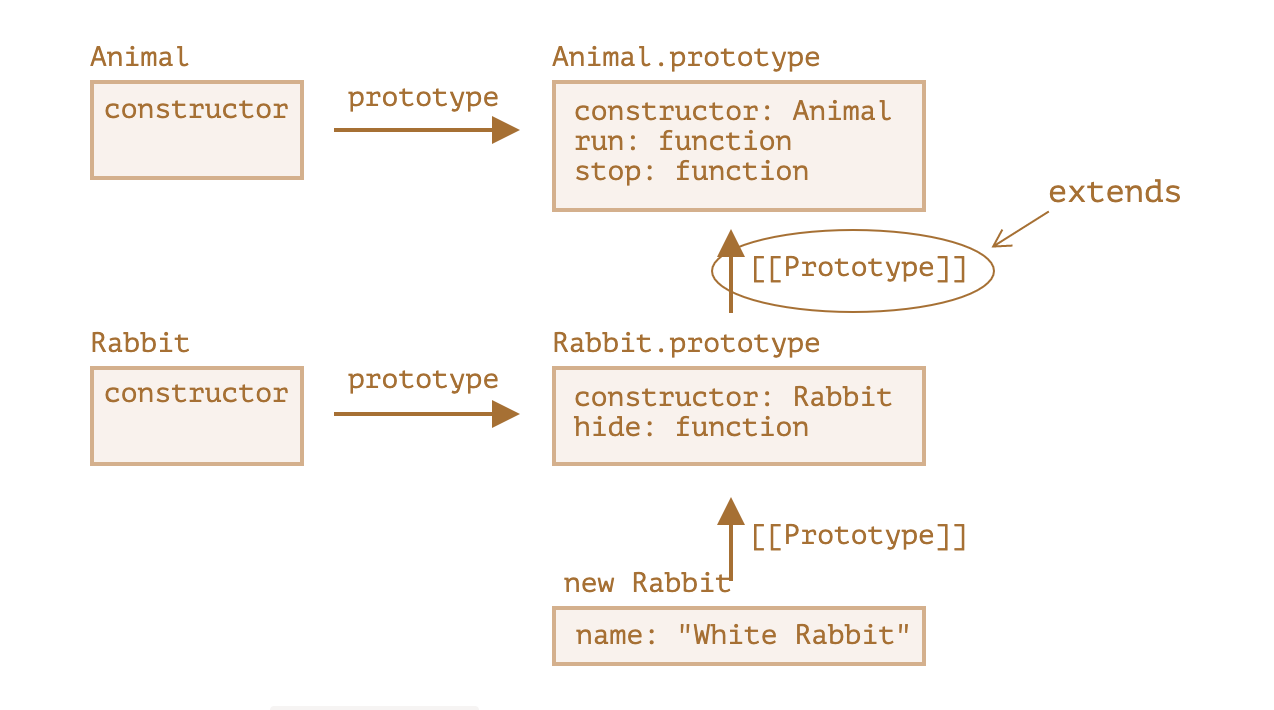# 原型和原型链

# 原型
每个对象上岗都有一个隐式原型[[prototype]],要么是 null,要么是对另一个对象的引用, __proto__ 是原型的操作方法(set get)
现在可以使用 Object.getPrototypeOf/Object.setProtitypeOf
this 指向的是 点操作符前面的对象
for...in 会迭代整个原型链上的属性 可以用 hasOwnPropProperty(key)
# 设置和访问原型的现代方法
- Object.creat(proto,[])—— 利用给定的 proto 作为 [[Prototype]](可以是 null)和可选的属性描述来创建一个空对象。
- Object.getPrototypeOf(obj)—— 返回对象 obj 的 [[Prototype]](与 proto 的 getter 相同)。
- Object.setPrototypeOf()—— 将对象 obj 的 [[Prototype]] 设置为 proto(与 proto 的 setter 相同)。
当用户输入一个proto作为 key 的时候会发生错误 原型只能是 null 或对象,想要避免可以使用 map 对象,或者利用 Object.creat(null) 创建一个没有原型继承的对象,这个时候使用proto就没有问题啦
# 原型链
基本思想是利用原型继承引用类型的多个方法和属性,当我们读取一个缺失的属性时,会自动去原型上寻找。
# 原型继承
主要实现是通过 构造函数的 prototype 属性,这个属性指向的是[[prototype]] 隐式原型
F.prototype 只在 new F 的时候有用,当 new 完了之后改变 prototype 新 new 的 F 会改变原型 已经 new 过的不会改变
- F.prototype 属性(不要把它与 [[Prototype]] 弄混了)在 new F 被调用时为新对象的 [[Prototype]] 赋值。
- 原型要么时 null 要么是一个对象,其他不起作用。
- F.prototype 只有一个属性 constructor 指向函数本身
- 当重写 prototype 时要避免覆盖 constructor
# 类
类长这样
class MyClass {
prop = value; // 属性
constructor(...) { // 构造器
// ...
}
method(...) {} // method
get something(...) {} // getter 方法
set something(...) {} // setter 方法
[Symbol.iterator]() {} // 有计算名称(computed name)的方法(此处为 symbol)
// ...
}
技术上来说,MyClass 是一个函数(我们提供作为 constructor 的那个),而 methods、getters 和 settors 都被写入了 MyClass.prototype。
# 不仅仅是语法糖
function User(name){
this.name = name
}
// User.prototype 属性上默认有 constructor 属性
// 在原型上设置一个函数
User.prototype.sayHi() = ()=>{
console.log(this.name)
}
const user = new User('xiaowo')
user.sayHi() //xiaowo
这样实现了一个类 但是有一些差异
- 通过 class 创建的类内部特殊标记属性 [[IsClassConstructor]]:true 只能用 new 创建 和函数不一样。
- 类的方法不能枚举/不可迭代,这样很好因为我们在使用 for...in 的时候不希望方法出现
- 类会自动进入严格模式
# 类继承
extend 关键字
# 实现原理
是利用原型的继承,new 出来的子类的 [[prototype]] 指向子类的 prototype 属性,指向父类的 [[prototype]] 也就是父类的 prototype
如图

# 类的高阶
# 重写 constructor
我们都知道子类继承父类的时候会调用 super() 来用父类的构造函数完成子类的创建。并且一定要在 this. 调用之前
# 原因
子类的构造函数和普通类的构造函数有区别。子类的构造器中有一个特殊的内部属性 [[ConstructorKind]]:"derived" 这会影响 new 的行为
- 当 new 一个常规函数的时候会创建一个空对象,把空对象赋值给 this
- 继承的 constructor 执行的时候不会执行该操作 会让其父类的 constructor 执行
因此,需要使用 super 来执行父类的构造函数,否则 this 指向的的那个对象不会被创建。
# 注意点
class Animal {
name = "animal";
constructor() {
alert(this.name); // (*)
}
}
class Rabbit extends Animal {
name = "rabbit";
}
new Animal(); // animal
new Rabbit(); // animal
子类没有打印自己的 name
父类构造器总是会使用它自己字段的值,而不是被重写的那一个。
但是换一种方法再看一下
class Animal {
showName() {
// 而不是 this.name = 'animal'
alert("animal");
}
constructor() {
this.showName(); // 而不是 alert(this.name);
}
}
class Rabbit extends Animal {
showName() {
alert("rabbit");
}
}
new Animal(); // animal
new Rabbit(); // rabbit
问题出在字段初始化的顺序上,是这样初始化的:
- 对于基类(还未继承任何东西的那种),在构造函数调用前初始化。
- 对于子类(派生类),在 super() 后立刻初始化。
# [[HomeObject]]和内部探究
关于 super 背后的原理 我们知道 super.method 可以调用父类上的方法,看起来很容只需要使用 this.proto.method ,但其实没有这个简单
例子如下
let animal = {
name: "Animal",
eat() {
alert(`${this.name} eats.`);
},
};
let rabbit = {
__proto__: animal,
name: "Rabbit",
eat() {
// 这就是 super.eat() 可以大概工作的方式
this.__proto__.eat.call(this); // (*)
},
};
rabbit.eat(); // Rabbit eats.
这样是没有问题的 但是如果再增加一层继承
let animal = {
name: "Animal",
eat() {
alert(`${this.name} eats.`);
},
};
let rabbit = {
__proto__: animal,
eat() {
// ...bounce around rabbit-style and call parent (animal) method
this.__proto__.eat.call(this); // (*)
},
};
let longEar = {
__proto__: rabbit,
eat() {
// ...do something with long ears and call parent (rabbit) method
this.__proto__.eat.call(this); // (**)
},
};
longEar.eat(); // Error: Maximum call stack size exceeded
这样就报错了
原因是 this 始终指向的是 loneEar 所以 就无法向上去查找方法了
解决方法 [[HomeObject]]
# [[HomeObject]]
当一个函数被定义为类或者对象方法时,它的 [[HomeObject]] 属性就成为了该对象。
然后super 通过它来解析 父原型上面的方法
let animal = {
name: "Animal",
eat() { // animal.eat.[[HomeObject]] == animal
alert(`${this.name} eats.`);
}
};
let rabbit = {
__proto__: animal,
name: "Rabbit",
eat() { // rabbit.eat.[[HomeObject]] == rabbit
super.eat();
}
};
let longEar = {
__proto__: rabbit,
name: "Long Ear",
eat() { // longEar.eat.[[HomeObject]] == longEar
super.eat();
}
};
// 正确执行
longEar.eat(); // Long Ear eats.
并没有用this 而是通过[[HomeObject]]的记录
只有在使用super的时候才会去使用 [[HomeObject]],如果不使用super 还是可以被自由的调用
!!! 注意在函数中使用的super 被其他地方调用时 this不会变成.前面的 而是 [[HomeObject]] 中保存的
!!! 要使用函数 而不是属性 使用属性赋值为函数时 是没有 [[HomeObject]] 记录的
let animal = {
eat: function() { // 这里是故意这样写的,而不是 eat() {...
// ...
}
};
let rabbit = {
__proto__: animal,
eat: function() {
super.eat();
}
};
